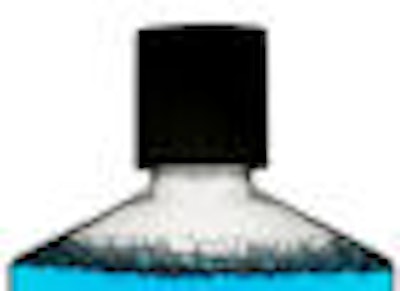
The essential oils in Listerine Antiseptic penetrate plaque biofilm better than competing mouth rinses that rely on other active ingredients, according to a study presented at the recent American Association for Dental Research annual meeting.
The study was led by Danette Nittel, MS, a microbiologist in research, development, and engineering at Johnson & Johnson Healthcare Products Division, makers of Listerine Antiseptic. The findings further support the mechanism of essential oils to control plaque and gingivitis, according to Nittel and her team.
They conducted two lab studies to study the penetration effect of Listerine Antiseptic and mouth rinses that contain cetylpyridinium chloride (CPC) or chlorhexidine (CHX), mouthwashes on statically grown, mixed-species biofilm or biofilm grown under flow conditions.
In both cases stimulated saliva was collected from donors, pooled, and homogenized.
In the first laboratory study, biofilm was grown statically for 48 hours. Saliva pellicle was formed in polystyrene plates. Saliva was then replaced with saliva/media mixture and incubated shaking at 35° C for 48 hours with media changes twice daily. It was then subjected to one 30-second treatment rinse.
A separate extended laboratory study consisted of biofilms grown under flow conditions.
In this case saliva was dispensed into a 12-channel biocassette to form a pellicle on HA disks suspended from a fitted lid into the 12-channel biocassette. The biocassette was attached to a 24-channel continuous flow peristaltic pump system in a 30.5° C chamber. Media were added allowing biofilms to form. Biofilms were grown over 60 hours and were subjected to twice-daily treatments over the duration of those 60 hours (with five hours between treatments).
After the final treatment, the biofilms were harvested and analyzed for adenosine triphosphate bioluminescence. Samples were stained using a live/dead stain cocktail. Viability was analyzed using a confocal microscope. 3D images were generated and analyzed to visualize penetration. Stains are reported as percent live/dead.
Multispecies static biofilm
|
Multispecies flow biofilm
|
The study results indicated that in both models, the EO mouth rinse showed the deepest penetration via live/dead stain over CPC and CHX mouth rinses. In the flow model, the EO mouth rinse exhibited superior biofilm kill compared to CPC and similar kill compared to CHX, noted the study authors.
"These lab studies demonstrate that Listerine Antiseptic is able to penetrate plaque biofilm better than other mouth rinses, further supporting the mechanism of essential oils to control plaque and gingivitis," Nittel told DrBicuspid.com. "We used established visual methodology -- including confocal laser microscopy -- to take it a step further by designing and implementing new biofilm models through the evaluation of new dye combinations."
This improved the stain ability and resolution and demonstrated that Listerine Antiseptic exhibited deeper penetration via live/dead stain when compared to CPC and CHX, she added.
"It's a dental professional's responsibility to provide patients with science-based information on clinically proven brands that extend care beyond the dentist chair," Nittel said. "This data reinforces the effectiveness of Listerine Antiseptic previously published in clinical trials and underlines the importance of rinsing twice daily for optimal germ kill efficacy."



















